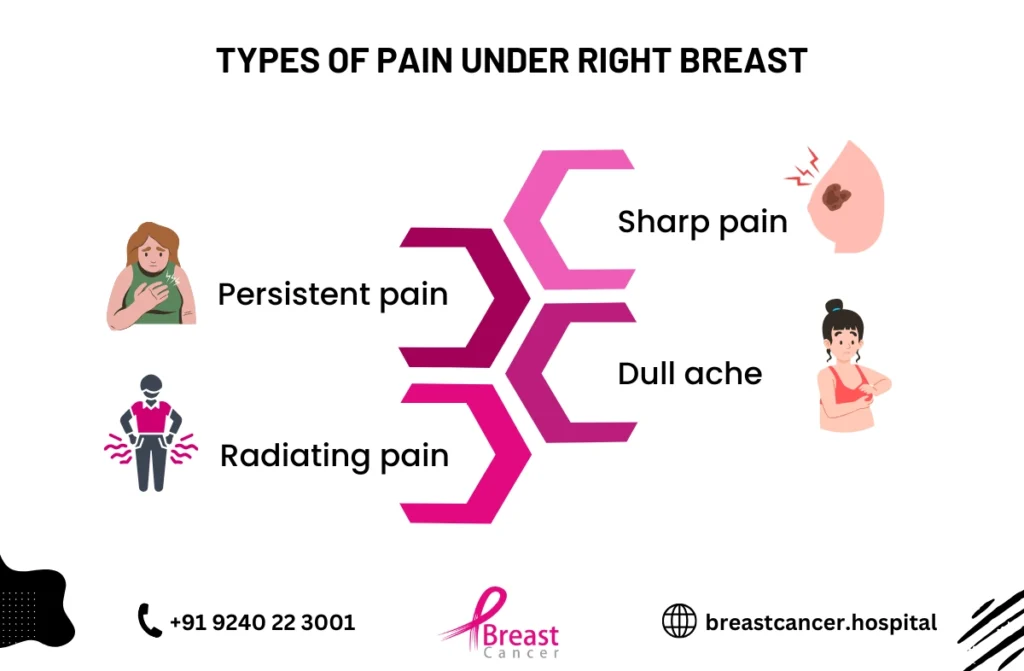Pain under right breast can feel alarming, but it’s essential to understand what may be causing it. While many cases are harmless and easily treatable, others might indicate more serious conditions such as breast cancer or issues with nearby organs. In this blog, we’ll explore the potential causes, symptoms, and treatments for this discomfort.
What Causes Pain Under Right Breast?
- Muscle strain: Overexertion, exercise, or lifting heavy objects can strain the chest muscles.
- Digestive issues: Problems like acid reflux or gallstones can cause pain radiating to this area.
- Liver problems: Conditions like hepatitis or fatty liver disease can contribute to discomfort.
- Respiratory conditions: Infections or inflammation in the lungs may lead to pain under right breast when breathing.
- Breast cancer: Though less common, it’s vital to rule out this serious condition through proper medical evaluation.
Understanding what causes pain under right breast is the first step to finding relief and understanding how to manage the issue effectively.

Types of Pain Under Right Breast
The type of pain under right breast can vary depending on its cause. It’s crucial to recognize the nature of the discomfort to guide proper treatment:
- Sharp pain: Often linked to muscle strain or nerve irritation.
- Dull ache: Could indicate digestive or liver problems.
- Radiating pain: Pain spreading to the back or shoulder might suggest gallbladder or respiratory issues.
- Persistent pain: If the pain doesn’t subside, it’s important to consult a doctor to rule out conditions like breast cancer.
Recognizing these types can help narrow down potential causes and guide appropriate medical advice tailored to your symptoms.
Is Pain Under Right Breast a Heart Attack?
It’s not typically linked to a heart attack. However, it’s worth noting that heart attack symptoms can sometimes mimic chest pain. Be alert for accompanying symptoms such as:
- Shortness of breath
- Pain radiating to the left arm, jaw, or back
- Cold sweats
- Nausea or dizziness
Symptoms of Right-Side Chest Pain
Symptoms of pain under right breast may vary, but here are some common signs to watch for:
- Localized pain: Sharp or aching pain under the breast area.
- Swelling or tenderness: This may indicate an injury or inflammation.
- Difficulty breathing: Pain that worsens with deep breaths could suggest a respiratory issue.
- Radiating pain: Discomfort extending to the back or shoulder may point to gallbladder or liver problems.
Monitoring these symptoms will help your doctor determine the underlying cause of your discomfort and offer precise treatment plans.
How is Right-Side Chest Pain Treated?
Treatment for pain under right breast depends on its cause. Common approaches include:
- Rest and ice: Useful for muscle-related pain.
- Medications: Pain relievers, antacids, or antibiotics may be prescribed.
- Lifestyle changes: Adopting a healthy diet and regular exercise can help manage digestive and liver issues.
- Surgical intervention: In severe cases like gallstones or tumors, surgery may be necessary.
10 Common Causes of Breast Pain
Understanding the causes of pain under right breast is essential. Here are ten possible reasons:
- Muscle strain: Overuse or injury can lead to soreness.
- Gallstones: These can cause sharp, radiating pain.
- Liver disease: Conditions like hepatitis may result in discomfort.
- Costochondritis: Inflammation of the cartilage in the ribcage can cause chest pain.
- Respiratory infections: Pneumonia or bronchitis can lead to pain under right breast when breathing.
- Acid reflux: Stomach acid irritation can radiate pain to the chest.
- Breast infection: Infections like mastitis can cause swelling and pain.
- Cysts: Breast cysts may create localized tenderness.
- Shingles: A viral infection affecting nerves can result in chest pain.
- Breast cancer: Though less common, it’s vital to rule out this serious condition.
These causes highlight the diverse nature of this type of pain and why a medical diagnosis is critical.
Pain Under Right Breast When Breathing
Pain under right breast when breathing can feel particularly distressing. Often, this discomfort arises from respiratory or musculoskeletal issues, such as:
- Pleurisy: Inflammation of the lining around the lungs.
- Rib injury: Fractures or bruises can worsen with deep breaths.
- Pneumonia: Infection in the lungs may lead to pain while breathing.
- Pulmonary embolism: A blood clot in the lungs requires immediate attention.
If you’re experiencing pain under right breast when breathing, especially if it’s severe or persistent, consult a healthcare provider immediately. Ignoring the condition can lead to complications.
What Causes Pain Under Right Breast Radiating to Back?
What causes pain under right breast radiating to back? This type of discomfort often points to issues like:
- Gallstones: Pain from the gallbladder may spread to the back or shoulder.
- Kidney problems: Infections or stones in the kidney can radiate pain.
- Liver disease: Swelling or inflammation in the liver may cause discomfort radiating to the back.
- Nerve issues: Pinched nerves in the spine can create referred pain.
Understanding what causes pain under right breast radiating to back can help determine whether the issue requires urgent medical care or lifestyle adjustments.
What Causes Pain Under the Right Breast?
You might wonder, what causes pain under the right breast? This question often arises when the discomfort is persistent or unexplained. Causes may include:
- Gallbladder issues: Pain from gallstones can localize under the right breast.
- Lung infections: Pneumonia or bronchitis can cause localized pain.
- Liver conditions: Swelling or damage to the liver may lead to discomfort in this area.
- Muscle strain: Overuse or injury in the chest muscles can also cause significant pain.
Addressing what causes pain under the right breast begins with a proper diagnosis from a healthcare professional.
Preventing Pain Under the Right Breast
- Maintain a balanced diet: Reduce fatty and fried foods to lower the risk of gallstones and liver problems.
- Exercise regularly: Strengthen your muscles and improve overall health.
- Stay hydrated: Proper hydration supports organ function and reduces the risk of kidney stones.
- Practice good posture: Poor posture can strain chest muscles and nerves.
- Schedule routine check-ups: Early detection of conditions like breast cancer can save lives.
These simple steps can significantly reduce the likelihood of experiencing chest pain and other health issues.
Treatment Options
The treatment depends on the underlying cause. Here are some common options:
- Pain management: Over-the-counter pain relievers or prescribed medications.
- Physical therapy: Useful for muscle strain or posture-related issues.
- Dietary changes: Adjusting your diet can alleviate symptoms of digestive problems.
- Surgical interventions: Procedures like gallbladder removal for gallstones.
- Medical therapies: Antibiotics for infections or targeted treatments for conditions like breast cancer.
Conclusion
Pain under right breast can range from minor discomfort to symptoms of a serious condition like breast cancer. Understanding the potential causes, symptoms, and treatments is essential for taking the right steps toward relief. If you’re experiencing pain under right breast, don’t ignore it. Consult a medical professional to ensure your health and well-being.




